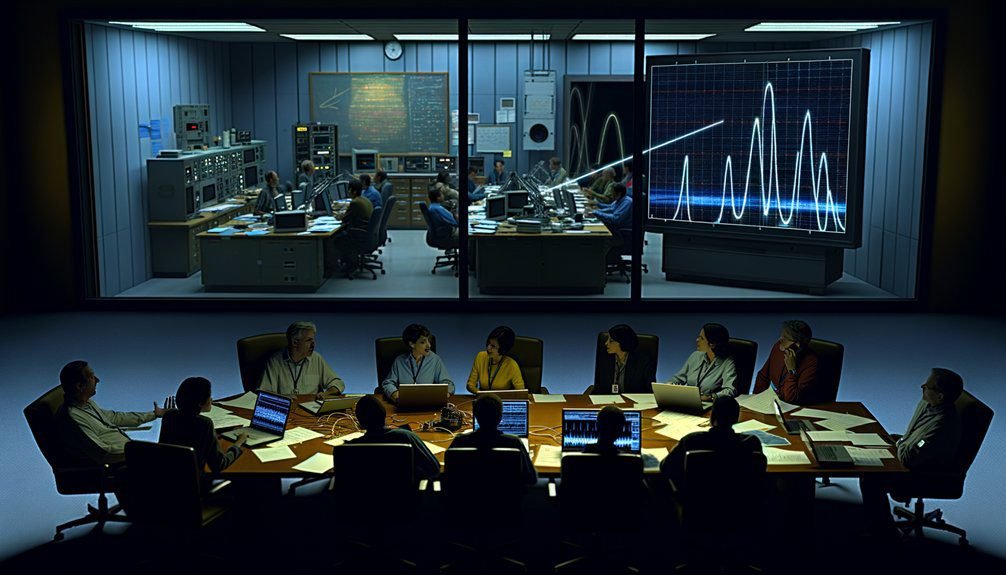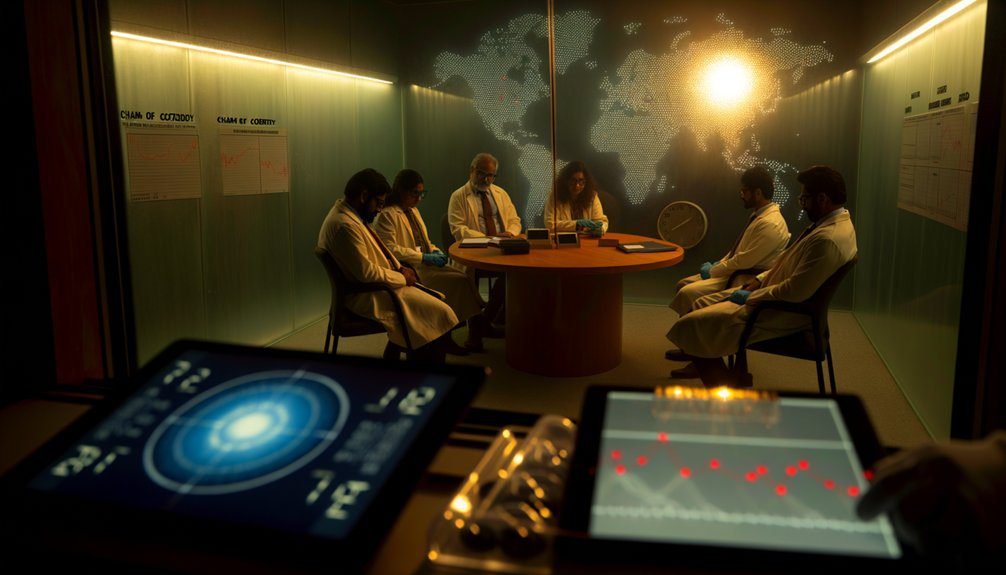When a promising signal appears, you’ll see rapid, transparent steps: teams verify instruments and rule out interference, share data in secure repositories, run independent cross-checks, and log analyses for peer review. Coordinated alerts go to international partners and scientific bodies while a designated spokesperson prepares careful public statements. Raw data and tools are often released for wider scrutiny and citizen science. You’ll get clear confidence levels, next steps, and ways to follow ongoing verification if you want more detail.
Key Takeaways
- Verify signals through repeated observations, interference checks, and independent instrument cross-checks before public disclosure.
- Log and store raw and processed data in centralized repositories with metadata and access controls for reproducibility.
- Coordinate verification and notification with international partners, scientific unions, and agreed protocols before broader announcements.
- Prepare concise public statements detailing detection, confidence level, methods, and next steps, and appoint an official spokesperson.
- Release data, analysis code, and educational resources openly while following ethical and disclosure guidelines for citizen engagement.
Scientific Verification and Peer Review

Because extraordinary claims demand extraordinary evidence, the moment a potential SETI signal appears it has to go through rigorous scientific verification and peer review before anyone can accept it. You’ll see teams immediately test for local interference, instrument error, and known astrophysical sources, documenting each step to preserve scientific integrity. Validation processes include independent re-observation with different telescopes, cross-checks by automated pipelines, and statistical analysis to rule out false positives. You’ll also find that data reduction and metadata are logged so peers can reproduce results. When the dataset survives these hurdles, researchers prepare a detailed report for submission to journals and preprint servers, inviting critical scrutiny. Peer reviewers assess methodology, assumptions, and alternative explanations; only then does the community consider broader implications. You’ll appreciate that this disciplined sequence protects the field’s credibility while ensuring any claimed discovery rests on transparent, verifiable evidence rather than excitement or error.
Internal Collaboration and Data Sharing
You’ll need centralized data repositories that let teams store, search, and version raw signals and processed results reliably. Establish clear cross-team analysis protocols so independent groups can reproduce findings and flag anomalies without stepping on each other’s workflows. Apply strict, role-based secure access controls to protect sensitive data while keeping collaboration efficient.
Centralized Data Repositories
When teams across institutions need to collaborate quickly and reliably, a centralized data repository becomes the single source of truth for SETI discoveries, letting you access, validate, and annotate raw signals, processed results, and metadata from one secure location. You’ll rely on rigorous data management to guarantee versioning, provenance, and standardized formats so every contributor understands origin and processing history. Repository accessibility is enforced through role-based permissions, secure APIs, and searchable indexes so you can retrieve relevant records without delay. Audit logs and automated integrity checks let you trust the content you see, while annotation tools let you attach notes, hypotheses, and review outcomes. Centralized repositories reduce duplication, speed verification, and make coordinated responses to candidate signals tractable and transparent.
Cross-Team Analysis Protocols
While a centralized repository gives you the data, cross-team analysis protocols define how teams actually work together on candidate signals — who has access, how analyses are handed off, and which standards govern result comparison and reporting. You follow explicit steps that enable cross disciplinary collaboration and consistent use of data integration techniques, so findings are reproducible and defensible.
- Define roles and responsibilities for signal vetting and interpretation.
- Standardize file formats, metadata, and preprocessing pipelines.
- Schedule iterative review cycles with documented annotations and versioning.
- Require consensus checkpoints and traceable audit trails before public communication.
These protocols keep analyses coherent across specialties, reduce duplication, and let you move confidently from internal evaluation to broader sharing.
Secure Access Controls
Having robust secure access controls lets teams apply the cross-team analysis protocols without exposing sensitive data or workflows. You’ll rely on role-based permissions, multi-factor authentication, and encryption to guarantee secure data remains reachable only to authorized contributors. Access protocols define who can view raw telemetry, processed results, or metadata, and they log every action for auditability. You’ll see time-limited credentials for external reviewers, compartmentalized datasets for preliminary checks, and automated alerts for anomalous access patterns. That structure preserves scientific integrity while enabling rapid collaboration across institutions. By enforcing least-privilege principles and regular credential reviews, you’ll reduce leak risk and maintain trust. Clear governance and technical controls make sharing discoveries both responsible and practical.
Coordinating With International Organizations
When you coordinate with international organizations, you’ll need to align on established protocols so every team responds to signals the same way. You’ll also build shared verification networks to cross-check detections rapidly and transparently. Clear roles, agreed standards, and regular exercises will keep the global response reliable and credible.
Established Protocol Alignment
Because any credible signal detection will touch governments, scientists, and the public across borders, you should prioritize aligning with established international protocols and organizations from the outset. You’ll work within frameworks that guide protocol development and discovery communication so messages are consistent, responsible, and legally aware. Key actions include:
- Engage with UN bodies, scientific unions, and space agencies to confirm procedural fit.
- Adopt agreed notification timelines and content standards to avoid confusion.
- Coordinate legal and ethical reviews with international partners before public release.
- Train your team on diplomatic channels and spokesperson roles to maintain credibility.
Shared Verification Networks
Though verification starts with your own instruments and procedures, effective confirmation of a candidate signal depends on a robust, preestablished network of international partners who can provide independent observations, complementary modalities, and legal-ethical oversight; coordinating with these organizations guarantees rapid cross-checks, reduces false positives, and preserves credibility across jurisdictions. You’ll rely on collaborative platforms to share timestamps, spectral data, and telescope scheduling in real time, letting colleagues attempt independent detections. Formal agreements define roles for radio, optical, and neutrino observatories, plus institutional review for ethical disclosure. Consistent data validation procedures—shared formats, calibration standards, and blind tests—ensure results are comparable. By engaging international bodies early, you speed confirmation, distribute responsibility, and protect scientific and public interests.
Preparing Public Statements and Press Releases

If you’re preparing a public statement or press release about a SETI discovery, focus first on a concise lead that clearly states what was detected, how confident the team is, and what the immediate implications are for both the scientific community and the public; that lead will set the tone for accuracy, transparency, and trust. You should align phrasing with your public communication goals and overall media strategy, using plain language without oversimplifying uncertainty.
- Describe the detection: signal type, instrument, timestamps.
- State confidence: verification steps completed, remaining checks.
- Explain implications: scientific context, what it doesn’t imply.
- Provide next steps: ongoing analyses, contact points, data access.
Keep sentences short and factual. Use quotes from lead scientists to humanize without sensationalizing. Include links to technical reports and data repositories so interested readers can dig deeper. Anticipate common questions and answer them directly in FAQs or sidebars to reduce misinterpretation.
Engaging Media and Hosting Press Conferences
After you’ve prepared a clear, factual statement, you’ll need a plan for engaging the media and hosting any press events so messaging stays accurate and calm. You’ll designate a spokesperson trained in media engagement, who’ll deliver concise talking points, clarify uncertainties, and steer speculation away from the podium. You’ll schedule press outreach that gives journalists time to verify details and access experts for follow-up questions. At the event, you’ll present evidence, explain methods, and outline next steps, then open a controlled Q&A so complex topics aren’t oversimplified. You’ll provide written materials and vetted visuals to reduce misunderstandings and make fact-checking straightforward. You’ll coordinate timing with partner institutions and legal counsel to avoid premature releases. You’ll also prepare for hostile or sensational angles by rehearsing responses that reaffirm scientific process and transparency. By planning logistics, access, and clear roles, you’ll keep coverage informative, measured, and focused on the science rather than hype.
Open Data Releases and Citizen Science Platforms

When you openly release SETI data and build citizen-science platforms, you expand scrutiny, accelerate discovery, and build public trust by putting methods and raw results where anyone can evaluate them. You get more eyes on anomalies, more reproducible analyses, and a transparent trail from observation to claim. Open data policies let you share calibrated files, processing code, and metadata so independent researchers can verify results.
- Publish raw and processed datasets with clear licensing and documentation.
- Provide user-friendly tools and tutorials to enable meaningful citizen engagement.
- Host reproducible analysis pipelines and versioned code repositories.
- Create validation workflows so volunteers’ findings feed back to professional review.
Educational Outreach and Public Events
How can SETI programs turn public fascination into lasting scientific literacy and support? You’ll see that they design educational programs that connect discoveries to the scientific method, data interpretation, and critical thinking. By offering modular curricula for schools and online resources, they let you explore real signal analysis and instrumentation concepts at your own pace.
Public workshops and outreach events give you hands-on experience: telescope demonstrations, guided data sessions, and panel talks with researchers. These events demystify terminology, show how hypotheses are tested, and invite you to contribute to follow-up observations or citizen science projects. Communicating uncertainties and process builds trust, so you’ll understand not just headlines but the evidence behind them.
SETI teams also partner with museums and community groups to reach diverse audiences, adapting content for different ages and backgrounds. That practical, transparent approach helps you become an informed supporter, ready to evaluate future claims and engage constructively with scientific developments.
Ethical Guidelines and Policy Considerations

Because contact with extraterrestrial intelligence would raise profound moral and practical questions, SETI programs need clear ethical guidelines and policy frameworks before any candidate signal is claimed or responded to. You’d expect protocols that address transparency, responsibility, and international coordination so the discovery process won’t be driven by haste or speculation. Consider these core actions:
Contact with extraterrestrial intelligence demands clear ethical guidelines, transparent protocols, and international coordination before any announcement or response.
- Establishing disclosure rules that balance openness with verification to manage public reaction.
- Defining who’s authorized to issue statements and how scientific consensus is reached.
- Creating international agreements that respect sovereignty, scientific integrity, and cultural diversity.
- Preparing response policies that weigh risks, consent, and long-term impacts before any transmission.
You’ll want these measures to assess ethical implications like potential harm, exploitation, or misrepresentation. Policy frameworks should be living documents, revised as technology and social norms evolve. That way, you’ll have principled, practical guidance that protects science and society when discoveries demand responsible action.
Frequently Asked Questions
How Does SETI Handle Potential Legal Liability From Announcing Discoveries?
You’re cautious: SETI minimizes legal liability by following discovery protocols and established legal frameworks, so announcements’re vetted, verified, and coordinated with institutions. You’ll see multi-party confirmation, clear attribution, and careful wording to avoid false claims or defamation. You’re covered by institutional policies, counsel reviews, and agreements with partners to manage intellectual property, data sharing, and press engagement. You’ll find transparency, documented procedures, and risk assessments guide every public disclosure.
Can SETI Monetize Breakthrough Signals or Discoveries?
No — you can’t realistically expect SETI to monetize breakthrough signals or discoveries. Signal commercialization and discovery monetization collide with scientific norms, public-interest obligations, and international agreements; discoveries are treated as shared knowledge, not proprietary products. You’d face ethical, legal, and practical barriers: peer review, open data expectations, funding rules, and diplomatic considerations. If revenue is sought, you’d more likely fund outreach, education, or tech licensing, not exclusive sale of a detected signal.
What Contingency Plans Exist for False Positive Public Panic?
You’ll be prepared, you’ll be transparent, you’ll act fast. You’ll follow public communication protocols, verify signals, and coordinate with independent observatories to rule out false positives. You’ll activate crisis management plans that include clear briefings, designated spokespeople, and staged information releases to prevent panic. You’ll correct misinformation quickly, provide regular updates, and engage with media and authorities so the public stays informed, calm, and confident in the process.
Does SETI Coordinate With Military or Intelligence Agencies?
Generally, you won’t see SETI directly coordinating operationally with military or intelligence agencies. SETI projects follow collaboration protocols with academic institutions and international observatories, and they’ve established security measures to protect data and control releases. If a credible, high-stakes detection occurred, SETI would consult governmental or international authorities per agreed protocols. You’d expect transparency, scientific review, and careful coordination to balance public communication and national security concerns.
How Are Individual Contributors’ Intellectual Property Rights Protected?
You’re protected by clear contributor agreements that specify ownership, licensing and how intellectual property is used. Those agreements usually let you retain IP while granting SETI projects a limited license to analyze and publish results. They also spell out attribution, data handling and dispute procedures. Read terms carefully, negotiate if needed, and keep records of your submissions. If you’re unsure, seek legal advice before contributing.